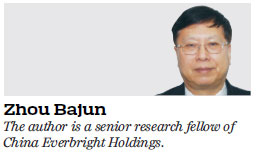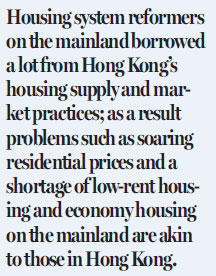HK should take a leaf from Shenzhen's housing reform book
Updated: 2018-06-20 07:06
By Zhou Bajun(HK Edition)
|
|||||||
The Shenzhen municipal government on June 5 published a consultation paper on deepening the city's housing system reform, including a housing development target of building 1.7 million residential units by 2035, of which 60 percent will be subsidized units according to government policy or public rental units, including low-rent apartments, "economy housing" and perks for talents; the rest will be for sale on the property market.

The urban housing system reform in cities and towns on the mainland began 20 years ago. In July 1998 the State Council issued a circular on urban housing system reform. As a result urban residential housing soon became commercial and monetized from mostly government-owned rentals before; almost all tenants became owners of their residential units.
In hindsight the sudden jump from practically no urban residents owning their own homes to almost all urban residents being homeowners was from one extreme to the other, or over-compensating. That said, even if someone foresaw the housing system reform would become such a big headache there was no way anyone would have been able to stop it because, just imagine, when rental units became personal property with just a few tens of thousands of yuan investment and can now sell for several times or even dozens of times more, who on Earth would not take that opportunity to become homeowners? Since the urban housing system reform emphasizes equal opportunity, it is only natural for it to be "over-compensating". There was no other way to go about it really.
The real problem is that, because private housing market prices keep rising and local governments become increasingly dependent on land sales for fiscal revenue, local governments have invariably overlooked housing development for social security (low-rent and economy housing) and a supply mechanism unaffected by the private housing market.
Shenzhen's residential housing system reform also began 20 years ago. It now experiences the same problems as a result of "over-compensating". Today, the municipal government is following President Xi Jinping's instruction that "residential housing is for people to live in, not to speculate over" and is sharply increasing land supply for housing development particularly for subsidized housing according to government policy and public-rental housing units for social security purposes in a bid to rectify the "over-compensated" situation. The proposed deepening reform measures for public consultation are considered the boldest among major cities on the mainland so far and could put Shenzhen ahead of all other cities in the public housing to commercial housing ratio if the new reform package is adopted, some commentators suggest.

Housing system reformers on the mainland borrowed a lot from Hong Kong's housing supply and market practices; as a result problems such as soaring residential prices and a shortage of low-rent housing and economy housing on the mainland are akin to those in Hong Kong. This is why Shenzhen's new housing system reform measures can inspire Hong Kong.
Firstly, the Shenzhen government's confidence in sharply increasing land supply for residential development is a good example for the Hong Kong government. Shenzhen has allocated 35 square kilometers (3,500 hectares) more land for housing, which will add 1.7 million residential units by 2035. This obliges the Shenzhen government to find enough land to achieve the goal in the next five to 10 years. In comparison, the special administrative region government projects in the "2030+" long-term development vision that the city will need at least 4,800 hectares of land for public and subsidized housing construction, but there will still be a 1,200 hectare shortage even if all the short-, intermediate- and long-term land supply goals are successfully met. The Land Supply Task Force appointed by the SAR government has criticized the government for overlooking local residents' desire for "bigger flats", greater need for healthcare and day-care facilities for senior citizens as a result of the aging population and more land reserves for unforeseen needs when it made the "2030+" predictions.
Secondly, in Shenzhen low-rent and economy housing units set aside according to government policy are not linked to the private housing market. This is in order to ensure they serve their social security purposes as intended. In sharp contrast public housing rents and subsidized housing prices in Hong Kong have been rising in proportion to private housing market increases to the demise of their original purpose. It is time the SAR government as well as Hong Kong society corrected this mistake.
Thirdly, Shenzhen's plan includes a certain number of housing units for high-caliber talents recruited from outside the city, a measure many other mainland cities have taken, too. Since Hong Kong is also determined to attract more talents from outside the SAR the government should perhaps consider borrowing a page from Shenzhen's playbook.
Such residential units should be better than public (low-rent) and subsidized housing units in design and size and will only be available to talents recruited from outside Hong Kong to lease or purchase. Such units cannot be sold on any housing market. If the owners of such units must leave Hong Kong for good they can only sell them back to the SAR government, which can sell them to other qualified talents recruited from outside Hong Kong.
(HK Edition 06/20/2018 page8)